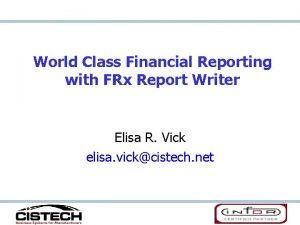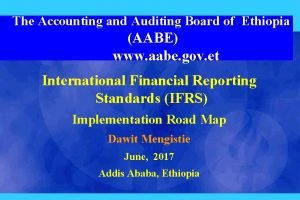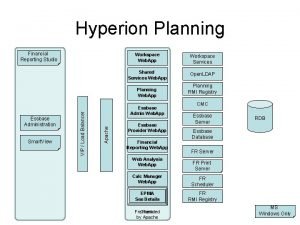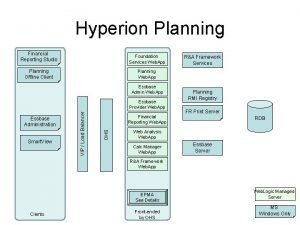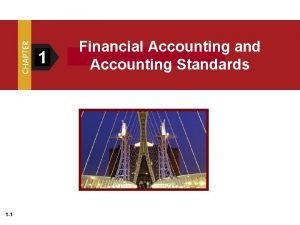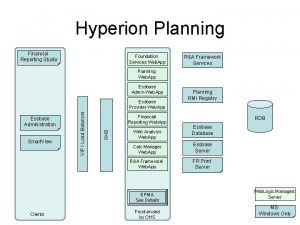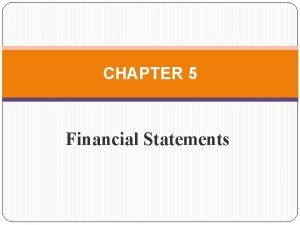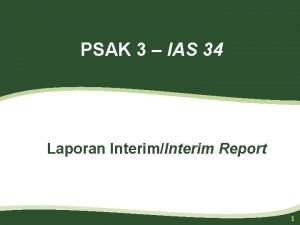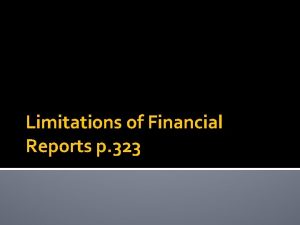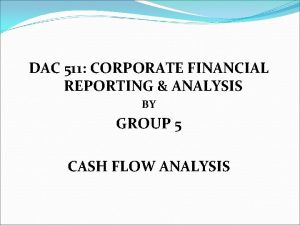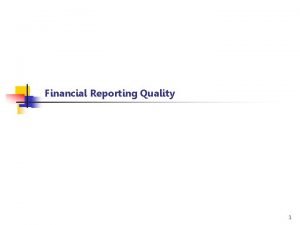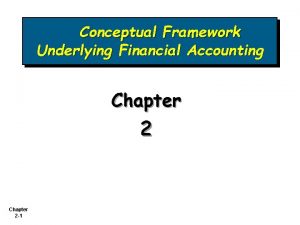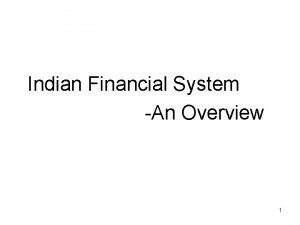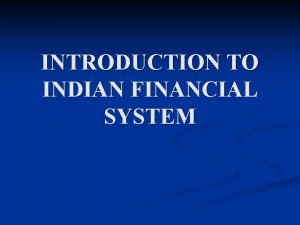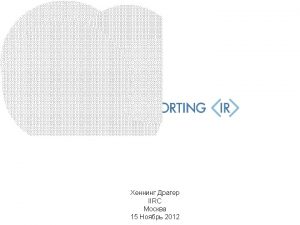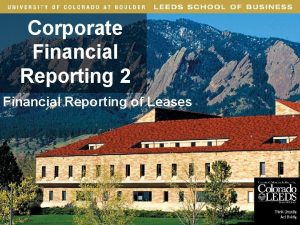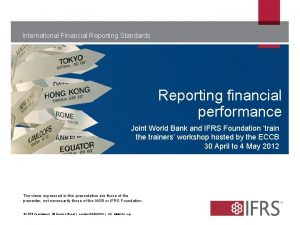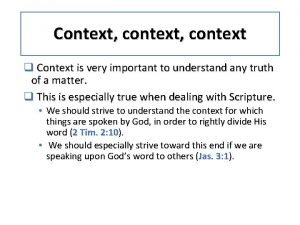RECENT TRENDS IN FINANCIAL REPORTING INDIAN CONTEXT INDIAN




































- Slides: 36

RECENT TRENDS IN FINANCIAL REPORTING – INDIAN CONTEXT

INDIAN FINANCIAL REPORTING SYSTEM In order to maintain uniformity and enable inter and intra firm comparison, the disclosure requirements are governed by : • The Companies Act, 2013 • SEBI Requirements

1. SEBI Requirements Under section 3 of SEBI Act 1992, with statutory powers for : • Protecting the interests of investors • Promoting the development of the securities market and • Regulating these securities market

Its regulatory jurisdiction extends over corporate in the issuance of capital and transfer of securities, in addition to all intermediaries and persons associated with securities market. It has the power for : • Regulating the business in stock exchanges and any other securities markets • Registering and regulating the working of stock brokers, sub-brokers, etc. • Promoting and regulating self-regulatory organizations • Prohibiting fraudulent and unfair trade practices

Some important requirements are as follows: • Dispatch of a copy of the complete & full annual report to the shareholders (Clause 32). • Disclosure on the Y 2 K preparedness level (Clause 32). • Disclosure of Cash Flow Statement (Clause 32). • Disclosure of material developments and price sensitive informations (Clause 36). • Compliance with Takeover Code (Clause 40 B).

• Disclosure of interim unaudited financial result (Clause 41) • Disclosure regarding listing fee payment status and the name and address of each stock exchange where the comapany’s securities are listed (Clause 48 B) • Corporate governance report (Clause 49). • Compliance with Accounting Standards issued by the ICAI (Clause 50).

2. Companies Act 2013 Requirements a) As per section 2 (40) of the Companies Act, 2013, the Financial statements of the company should include: - • A balance sheet • A profit and Loss account • Cash flow statement • A statement of changes in equity , if applicable • Any explanatory note

b)The MCA (Ministry of Corporate Affairs) on 6 April 2016, amended Schedule III to the Companies Act 2013 , the amendment divides Schedule III into two parts: • Division I – whose financial statements are required to comply with the current accounting standards • Division II – whose financial statements are drawn up in compliance with Ind AS.

The following is and overview of the Division II of the Schedule III: • It is applicable to every company to which Ind AS apply in preparation of its financial statements. • When a company is required to prepare consolidated financial statements

The general instructions for the prepareation of financial statements are as follows: A. Balance sheet • Schedule III provides a format of the balance sheet • Items presented in the balance sheet are to be classified as current and non-current. • Schedule III does not permit companies to avail of the option of presenting assests and liabilites in the order of liquidity

B. Statement of profit and loss • Schedule III provides a format of the statement of profit and loss • The statements of profit and loss is to be presented in accordance with the nature of expenses and would include profit or loss for the period and other comprehensive income for the period

C. Statement of changes in equity • This is a new concept for preparers of financial statements that have historically prepared financial statements under Indian GAAP. • The Statement of changes in equity would reconcile opening to closing amounts for each component of equity including reserves and surplus.

4. STATEMENT OF CASH FLOWS The Statement of cash flows would be presented when required in accordance with Ind AS 7, Statement of Cash Flows

5. NOTES Notes containing information in addition to that which is presented in the financial statements would be provided , including where required, narrative descriptions recognized in the financial statements. Indian financial reports include much more than the above stated legal minimum requirements. The following are the most common elements:

Notice of annual general meeting Chairman report* Summary of financial results* The financial highlights for a no. of years* Director’s report Corporate governance report Balance sheet Profit and loss account Cash flow statement

Supplementary statements Value added statements* Corporate social report* Environment report* Information on brand* EVA report* Business Responsibility report*

II. MODERN VOLUNTARY DISCLOSURES (A) Management policies & overview of company -Product & Product range -Area of specialization -Customers profile & market stage -Competitors -Future plans and trends -Financial goals -Govt. policy

(B) ECONOMIC VALUE ADDED - EVA is residual income after charging the company for the cost of capital provided by lenders and shareholders. -It is those companies which earn higher returns than cost of capital, that create value. - Big companies have started showing EVA information in their annual reports for the benefit of stakeholders.

(C) BRAND VALUE - - A Brand is much more than a trade mark or a logo. It is a trust mark of promise of quality & authenticity that client can rely upon. It is the financial pursuit that a buyer is willing to pay for a brand over a generic =or less worthy brand.

(D) HUMAN RESOURCE ACCOUNTING - HRA is one such process of measuring and reporting the human resources of an organization. - It is the process of identifying and measuring data about human resources & communicating the information to the interested parties. - There are two for valuing HRA Cost based approach value based approach

(E) OTHER VOLUNTARY DISCLOSURES Impact of inflation Corporate social responsibility Accounting and disclosure of environmental matter.

(F) LATEST MANDATORY REQUIREMENTS UNDER COMPANIES ACT 2013 1. - Report of board of directors should be ‘ATTACHED’ to the balance sheet laid before the AGM. Director report is intended to explain the shareholders, the company affairs, including its subsidiaries and the nature and scope of company’s business.

2. PROVISIONS RELATING TO DIRECTOR’S REPORT: A. APPLICABILITY OF PROVISION OF SECTION -134 OF DIRECTOR’REPORT B. SIGNING OF DIRECTOR’S REPORT: As per section 134(6) Board Report shall be signed by: 1. Its chairperson 2. At least 2 directors If there is no managing director then by 2 directors C. BASIS OF BOARD REPORT: The board report shall be prepared on the basis of STAND ALONE FINANCIAL STATEMENT OF THE COMPANY

D. Approval of board report 1. Approval of board report shall be done by in meeting of the board of director only 2. Meeting of board of directors can’t be done by ‘’video conferencing’’ E. E-FILING OF RESOLUTION FOR APPROVING BOARD REPORT:

3. CONTENT OF BOARD REPORT I. EXTRACT OF ANNUAL RETURN II. NO. OF BOARD MEETING III. COMMENT ON AUDITOR REPORT IV. COMMENT ON SECRETARIAL Audit report V. Particular of loan and investment

6. DISCLOUSURE OF RELATED PARTY TRAN 7. DIVIDEND RECOMMENDED 8. POST BALANCE SHEET EVENTS 9. RISK MANAGEMENT POLICY 10. CORPORATE SOCIAL RESPONSIBILITY

11. REPORT ON PERFORMANCE OF SUBSIDIARIES , ASSOCIATES AND JOINT VENTURE COMPANIES. 12. SECRETARIAL AUDIT REPORT: a. Every listed company and a company belonging to other class of companies as may be prescribed shall annex with its board report , a Secretarial audit report. b. The board of directors , in their report shall explain in full any qualification or observation or other remarks made by the Company Secretary

COMPANIES SHALL BE REQUIRED TO ANNEX SECRETARIAL AUDIT REPORT WITH DIRECTOR REPORT q. All listed companies q. Every public company having a paid up share capital of RS. 50 Crore or more. q. Every public company having a turnover of RS. 250 CRORE or more. 13. DISCLOUSURE ABOUT COST AUDIT

14. DISCLOUSURE OF BOARD REPORT: AS PER SECRETARIAL STANDARD OF ICSI SS-1 Annual report of company should disclose the no. Of meetings of board SS-2 Annual report should disclose particulars of general meeting held during last 3 year 15. DISCLOUSURE WHERE COMPANY IS REQUIRED TO CONSITUTE NOMINATION AND REMUNERNATION COMMITTEE. §The policy of qualification The remuneration of directors 16. DISCLOUSURE IF MD/WTD IS RECEIVING REMUNERATION OR COMMISION FROM A HOLDING COMPANY OR SUBSIDIARY COMPANY. 17. DISCLOUSURE OF VIGIL MECHANISM IN BOARD REPORT.

xviii. Disclosure of composition of audit committee and their recommendations not accepted : section – 117(8) • • • Composition of Audit Committee shall be disclosed in Board’s report of the company. If the board doesn’t accept recommendation of audit committees , it shall be disclosed along with reason in board’s report. xix. Declaration by independent director. • Director will disclose the statement on declaration given by Independent director • . xx. Details relating to deposit: • Details of deposit which are not in compliance with the requirement of chapter v of the act. • Deposit accepted during the year. • Unpaid and unclaimed deposit at the end of the year. • If there is any default in repayment of deposit or payment of interest thereon during the year then; number of such cases and total amount involved o At the beginning of the year o Maximum during the year o At the end of the year

xxi. Details of director KMP(Key Managerial Personnel) : There should be disclosure in the director’s report about: a. Director’s and KMP appointed during the year b. Director’s and KMP resigned during the year xxii. General disclosure’s a. Name of retiring directors and whether or not they offer themselves for reappointment b. Casual vacancies in the board filled during the year c. Re-appointment d. Casual vacancy in the board not filled during the year e. Changes in board during the year due to change in nominees, appointment of additional directors, death, resignation or any other reason f. Details if anyone is contesting for elections as director/small shareholder director xxiii. Disclosure about ESOP and sweat equity share: • • • Director report shall disclose following about sweat equity shares: (Rule 7 of unlisted companies issue of sweat equity shares) Rules 2003 Number of shares issued condition of issue of shares Pricing formula Total sweat equity share issued

• Money realized and benefit accrued • Diluted EPS pursuant to issue of sweat equity shares If ESOP has been given, its details are to be disclosed xxiv. Statement of the affairs of the company: generally following information is given about current year and previous year: • • • Turnover Profit Production of year xxv. Director perception of future of company: in this report directors perception of future of company given in consideration of: • • • Market competition Production constraints Government policies etc xxvi. Order of court: the details of significant and material orders passed by the regulators of court or tribunals impacting the going concern status and companies operation in future.

xxvii. Details of employees drawing salary above prescribed limits: • • Every listed company shall disclose in the board’s report the ratio of the remuneration and such other details as may be prescribed [197(12)]. The disclosures are summarized as below: Comparison between remuneration of managerial personnel and remuneration to employees. Details of employees drawing salary of Rs 500000/- or more per month. Details of remuneration to person holding 2% or more equity shares. Details of employees posted outside India. xxviii. Conservation of energy , technology absorption and foreign exchange dealing : Rule 8(3) the report of the board shall contain the following information and details , namely: A. Conservation of energy. I. The steps taken or impact on conservation of energy. II. The steps taken by the company for utilising alternate sources of energy. III. The capital investment on energy conservation equipments. B. Technology absorption. I. The efforts made towards technology absorption II. The benefits derived like product improvement, cost reduction, product development or import substitution.

III. In case of imported technology ( imported during the last three years reckoned from the beginning of financial year) -a. The details of technology imported b. The year of import c. Whether the technology been fully absorbed d. If not fully absorbed, areas where absorption has not taken place, and the reasons thereof e. The expenditure incurred on research and development C. Foreign exchange earnings and outgo. The foreign exchange earned in terms of actual inflows during the year and the foreign exchange outgo during the year in terms of actual outflows. xxix. Director responsibility statement 134(5) The directors responsibility statement referred to in clause (c) of subsection (3) shall state that— a. In the preparation of the annual accounts, the applicable accounting standards had been followed along with proper explanation relating to material departures; b. The directors had selected such accounting policies and applied them consistently and judgments and estimates that are reasonable and prudent so as to give a true and fair view of the state of affairs of the company at the end of the financial year and of the profit & loss of the company for that

c. The directors had taken proper and sufficient care for the maintenance of adequate accounting records in accordance with the provision of this act for safeguarding the assets of the company and for preventing and detecting frauds and other irregularities. d. The directors had prepared the annual accounts on a going concern basis e. The directors , in the case of a listed company , had laid down internal financial controls to be followed by the company and that such internal financial controls are adequate and were operating effectively. f. The directors had devised proper systems to ensure compliance with the provisions xxx. Other details: a. The names of companies which have become or ceased to be its subsidiaries, joint ventures or associated company during the year. b. The change in the nature of business , if any c. The financial summary or highlights d. The details in respect of adequacy of internal financial controls with reference to the financial statements e. Major evens concerning the company are highlighted.

THANK YOU
 Modern trends of foreign trade in india
Modern trends of foreign trade in india Recent trends in ic engine
Recent trends in ic engine Current trends in project management
Current trends in project management Recent trends in mis
Recent trends in mis Financial literacy trends
Financial literacy trends Nonagist
Nonagist High context vs low context culture ppt
High context vs low context culture ppt Pragmatics examples
Pragmatics examples Paraverbal adalah
Paraverbal adalah Frxdesigner
Frxdesigner Aabe
Aabe Purposes of financial statements
Purposes of financial statements What is financial reporting studio?
What is financial reporting studio? Financial reporting studio
Financial reporting studio Chapter 2 conceptual framework for financial reporting
Chapter 2 conceptual framework for financial reporting Accounting standards
Accounting standards What is financial reporting studio?
What is financial reporting studio? Ethiopian government accounting
Ethiopian government accounting Cbd financial reporting framework
Cbd financial reporting framework Ias 34 interim financial reporting
Ias 34 interim financial reporting Project management financial reporting
Project management financial reporting Limitations of annual reports
Limitations of annual reports Direct vs indirect cash flow
Direct vs indirect cash flow Chapter 2 conceptual framework for financial reporting
Chapter 2 conceptual framework for financial reporting International financial reporting standards 9
International financial reporting standards 9 Limitations of financial reporting
Limitations of financial reporting Conceptual framework underlying financial accounting
Conceptual framework underlying financial accounting Constituents of indian financial system
Constituents of indian financial system Regulatory institutions in indian financial system
Regulatory institutions in indian financial system Formal financial system
Formal financial system Evolution of indian financial system
Evolution of indian financial system Components of indian financial system
Components of indian financial system Recent developments in ict
Recent developments in ict Recent developments in object detection
Recent developments in object detection Ap synthesis prompt
Ap synthesis prompt Reading scanning
Reading scanning Recent demographic changes in the uk
Recent demographic changes in the uk









